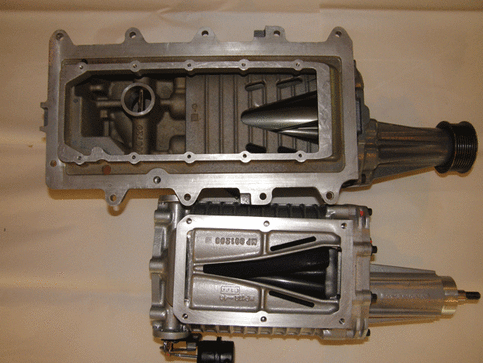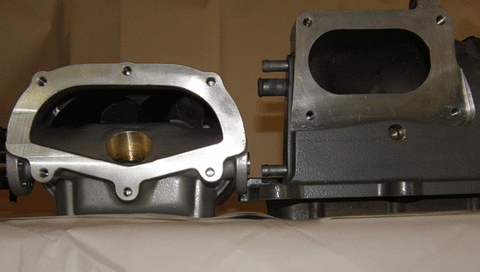What is the difference between an Eaton and Magnuson Supercharger?
Tork Tech is using a Magnuson MP112 supercharger in their kit, NOT a Eaton supercharger! “What’s the difference”, you ask? It is a common misconception that all M112 superchargers are the same, or at least similar in their design and performance. This is not the case and you should be aware of the differences and know why the Magnuson unit is superior to any factory Eaton M112 product.
Eaton superchargers are factory equipped on many performance cars and trucks because roots style superchargers spin freely when cruising (not under boost) resulting in no decrease in fuel economy. This is a very important consideration today with the high cost of fuel. Another important characteristic about Eaton superchargers is that they are very reliable and typically perform flawlessly for years of daily use.
Eaton superchargers were developed and designed for the OEM markets and meet all federal regulations including “noise pollution” standards. Roots style superchargers have a very distinctive “whine” when running that far exceeds federal noise limits if special measures are not taken. To address this issue for OEM applications Eaton reduces port timing and port size. This trade-off cures the noise issue but at the same time the reduced port duration and port area drastically reduce the supercharger’s efficiency resulting in poor airflow and greatly increased exit air temperatures.
From a pure performance point of view the factory Eaton supercharger is more than adequate but certainly can be improved upon. Many people resort to internal porting while others take the units off for replacement with better flowing superchargers. Because of this reputation of “good, but not great”, the “Eaton” blower has been the subject of negative stereotyping by many people.
Magnuson Products Corporation (www.MagnusonProducts.com) is Eatons’ approved performance aftermarket supercharger outlet for the USA. They have developed a line of stand alone high flow superchargers that incorporate Eaton roots style rotors and benefits from the Eaton components proven reliability. Although Magnuson makes a M112 supercharger as does Eaton for different applications such as the ’03/04 Cobra, there is only a bit of similarity between the two units. Because Magnuson superchargers are primary targeted to the aftermarket they do not need to meet federal noise regulation so their porting durations and port areas can be significantly larger resulting in vastly increased efficiencies and reduced exit air temperatures while still benefiting from roots fuel economy advantage and Eaton’s reliability advantage.
The pictures below illustrate the differences between a ‘03-04 Cobra supercharger and the Magnuson MP112. Both of these superchargers are 112 cubic inch displacement chargers and both are roots style.
Eaton superchargers are factory equipped on many performance cars and trucks because roots style superchargers spin freely when cruising (not under boost) resulting in no decrease in fuel economy. This is a very important consideration today with the high cost of fuel. Another important characteristic about Eaton superchargers is that they are very reliable and typically perform flawlessly for years of daily use.
Eaton superchargers were developed and designed for the OEM markets and meet all federal regulations including “noise pollution” standards. Roots style superchargers have a very distinctive “whine” when running that far exceeds federal noise limits if special measures are not taken. To address this issue for OEM applications Eaton reduces port timing and port size. This trade-off cures the noise issue but at the same time the reduced port duration and port area drastically reduce the supercharger’s efficiency resulting in poor airflow and greatly increased exit air temperatures.
From a pure performance point of view the factory Eaton supercharger is more than adequate but certainly can be improved upon. Many people resort to internal porting while others take the units off for replacement with better flowing superchargers. Because of this reputation of “good, but not great”, the “Eaton” blower has been the subject of negative stereotyping by many people.
Magnuson Products Corporation (www.MagnusonProducts.com) is Eatons’ approved performance aftermarket supercharger outlet for the USA. They have developed a line of stand alone high flow superchargers that incorporate Eaton roots style rotors and benefits from the Eaton components proven reliability. Although Magnuson makes a M112 supercharger as does Eaton for different applications such as the ’03/04 Cobra, there is only a bit of similarity between the two units. Because Magnuson superchargers are primary targeted to the aftermarket they do not need to meet federal noise regulation so their porting durations and port areas can be significantly larger resulting in vastly increased efficiencies and reduced exit air temperatures while still benefiting from roots fuel economy advantage and Eaton’s reliability advantage.
The pictures below illustrate the differences between a ‘03-04 Cobra supercharger and the Magnuson MP112. Both of these superchargers are 112 cubic inch displacement chargers and both are roots style.

Here is a picture of the superchargers’ exit ports. Notice how much larger and longer the Magnuson exit port is compared to the Eaton pictured above it!
The engineering department at Ford decided to specify part of the intake plenum be incorporated into the supercharger case including a 90 degrees bend. The Magnuson supercharger is a multi-purpose rear entry design, this is the reason the Eaton supercharger is so much longer.

Here is a Gen 5 Magnuson MP112 inlet port pictured on the left and a ‘03-04 Mustang Cobra Eaton supercharger on the right. The difference in inlet port area is clear. The Magnuson is about 150% larger then the Eaton. Roots style superchargers require a very high flow non-restrictive inlet to perform properly and the Eaton is clearly restrictive.
As you can see there is a major difference between the Magnuson and Eaton units. Magnuson does not make a blower to fit the Cobra, but if they did using the same unit that Tork Tech does, you would expect to pick up 40 to 80 HP if you upgraded to one of their units depending on the supercharger overdrive ratio and engine mods. Tork Tech is making similar power in their two-valve 4.6L kits as Ford did in their superior four-valve cylinder head Cobra engines and it can only be attributed to a superior supercharger, the Magnuson M112, and TTI’s outstanding attention to airflow through their large supercharger inlet plenum, lower intake manifold, and super efficient intercooler system.
